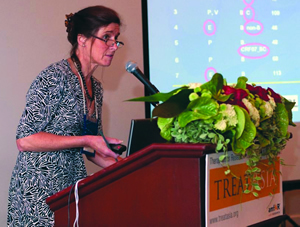HIV Genotyping: How It's Done
TREAT Asia Quality Assurance Program

Sally Land. (Photo: Louis Galdieri) |
October 2010—Determining whether an HIV-positive patient has become resistant to antiretroviral therapy (ART) requires complex genetic detective work to discover whether that patient's virus has changed or mutated in response to treatment. A multi-step process known as genotyping allows researchers to view the building blocks that make up the virus's genetic material and thereby detect mutations that signal the emergence of resistant virus.
The genotyping process begins when researchers extract viral nucleic acid from a patient's plasma and generate a DNA copy. Laboratory technicians amplify, or make multiple copies of, a specific region of the DNA using a technique known as polymerase chain reaction. The next step produces a picture of the DNA that reveals the sequence of its basic building blocks, known as nucleotide bases. This is done by running the amplified DNA through a series of chemical reactions.
The resulting product is placed in a DNA sequencer, which uses software to produce an image called an electropherogram showing each of the four nucleotide bases in a different color. Computer software is used to "read" the order of the bases in the sequence. However, in regions where two nucleotide bases coexist at the same position or where sequence quality is poor, electropherograms must also be examined visually to verify the computer reading. This visual analysis is one of the most subjective parts of the test and requires a great deal of training and expertise.
Once the patient's viral sequence has been determined, it can be submitted to an online database where the sequence is compared with a sequence from a prototype "wild-type" virus—HIV that does not contain mutations and is susceptible to ART. Mutations or differences in the patient's virus from the wild-type virus that have been shown to be associated with ART resistance are generated by these web-based applications, together with a set of scores indicating the patient's level of resistance to particular drugs. Scientists and treating doctors can review the web-generated ART report and take into account the patient's ART exposure when determining suitable treatment options.